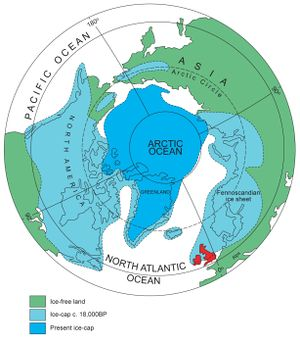Pleistocene, Northern Ireland: Difference between revisions
No edit summary |
m (1 revision imported) |
(No difference)
| |
Revision as of 10:49, 25 September 2017
| Mitchell, W I (ed.). 2004. The geology of Northern Ireland-our natural foundation. Geological Survey of Northern Ireland, Belfast. |
R A B Bazley
Pleistocene

The Pleistocene commenced with an episode of global cooling that led to vast accumulations of snow and ice in northern latitudes. The resulting polar ice sheet (P947878) expanded and contracted many times, on occasions engulfing Britain and Ireland and most of northern Europe [1]. During repeated cold episodes the landscape in Ireland was subjected to severe weathering and erosion, particularly during the last major glaciation which removed or substantially modified the pre-existing regolith. In the south of Ireland, older Pleistocene deposits include evidence of the Gortian Interglacial, a Middle Pleistocene warm period dated to about 365 000BP, which is succeeded by glacigenic sediments (tills) ascribed to the Munsterian Stage [2]. However, in Northern Ireland most glacial deposits are of Upper Pleistocene age, with at the base, evidence of a warm temperate stage here referred to the Last Interglacial (Ipswichian) Stage. The climate during the succeeding Midlandian Cold Stage was mainly made up of cold periods (stadials), interspersed with cool phases (interstadials). The last major glaciation peaked between about 24 000–18 000BP and engulfed all but the most southerly parts of Ireland and Britain.
Last Interglacial (Ipswichian) Stage
The oldest known fossiliferous Quaternary deposits in the north of Ireland are located at Benburb [H 810 520], Co. Tyrone. The strata, which are overlain by glacial till, consist of at least 4m of dark brown peat and grey lacustrine clay with assemblages of pollen and spores and plant macrofossils including seeds and angiosperm and conifer leaves. The pollen spectrum is indicative of a warm climate with forests of yew (Taxus), pine (Pinus), silver fir (Abies), alder (Alnus), hazel (Corylus), oak (Quercus) and holly (Ilex) [3]. Benburb is the first interglacial site to be recognised in Northern Ireland. The age of the deposit is uncertain. It was initially correlated with the Gortian (Hoxnian) Interglacial but the pollen assemblages may not be diagnostic of that interglacial and a correlation with the Ipswichian Interglacial is favoured here [4].
Midlandian Cold Stage
Prior to the last glaciation in the north of Ireland, climatic conditions ranged from cold glacial episodes to relatively short warmer phases with intervening cold periods characterised by permafrost. A tentative sequence of climatic changes associated with distinctive sediments including tills, stratified deposits and organic layers has been defined at a few sites in Northern Ireland. The correlation of sediments between sites is however, problematical and their assignment to early, middle or late episodes of the Midlandian is largely unsubstantiated by accurate dates. Nevertheless, this tripartite division of the Midlandian cold-climate period is convenient for descriptive purposes. The stadials are recognised by tills/diamicts and interstadials by organic remains.
References
- ↑ Osborne, R, and Tarling, D H. 1995. The Historical Atlas of the Earth (A Visual Exploration of the Earth’s Physical Past). Viking. Penguin Books Ltd., London
- ↑ Coxon, P. 1997. Pleistocene climate change: the evidence from Irish sequences. In: Sweeney, J ed.). Global change and the Irish environment. Royal Irish Academy, Dublin, 17–35.
- ↑ Boulter, M, and Mitchell, W I. 1977. Middle Pleistocene (Gortian) deposits from Benburb, Northern Ireland. Irish Naturalists Journal. 19, 2–3.
- ↑ Gennard, D E. 1984. A palaeoecological study of the interglacial deposit at Benburb, Co. Tyrone. Proceedings of the Royal Irish Academy. 84B, 43–55.